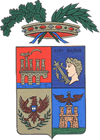
The port of Trapani, because of its curved shape, was named by the GreeksDrepanon, which means sickle. Because of the strategic positions of this port-city, it has been disputed by all the powers in prehistory as well as historic times. In fact, it was a naval base for the Phoenicians, Carthaginians, Greeks, Romans, Saracens and all the nations that dominated the Mediterranean Sea

Trapani has a population of about 70,000 inhabitants, with an economy based on the canning industry and fishing, in particular, the tuna fishing that is carried out in the traditional manner. Extremely important to the economy of the province is wine production, including Marsala wine. In addition, the economy benefits from the trading of sea salt.

The Egadi Islands are part of the province of Trapani and included Pantelleria, famous for Passito, a dessert wine, raisins and capers, abundantly used in Trapani’s kitchens and for its medical quality (it is a carminative).
When it comes to the table, Trapani is an experience for your senses. How impressive is the richness of its food, the colorful presentation, the flavors and its variety!
Cuscus alla Trapanese is made with semolina cooked in a fish broth, as opposed to the North African style in which couscous is served with meat and vegetable broth. Couscous cooked with water is offered as a dessert by adding milk, toasted almonds and pistachios, raisin, honey and sugar.
Carciofi a fucuneddu are steamed artichokes stuffed with a combination of chopped anchovies, onions, garlic, parsley and breadcrumbs.
There, tuna is cooked in every possible way: baked, barbecued, in sauce or fried and the taste is irresistible. Cernia alla Trapanese is sliced grouper cooked with vegetables and served with puree. The puree is also a delicious sauce when used as a condiment for spaghetti.
Other pasta dishes include spaghetti all’uovo di tonno; pasta seasoned with tuna fish bottarga (tuna fish eggs); pasta con aragoste, lobster sauce with tomato, garlic and herbs; spaghettini con melenzane, thin spaghetti with eggplants, tomatoes, capers, anchovies, peppers and olives; pasta al pesto Trapanese; and pasta simply seasoned with fresh, raw garlic, basil and oil or if you like, mix in chopped fresh tomato. These are some of the pasta specialties you can discover in every home and in modest local trattorie.
Pasticciotti di Mazzara, almond paste pastries stuffed with preserved apricots and citrons; ricotta cream turnovers baked or fried, called cassateddi; sfingi, which are fritters stuffed with raisins and dusted with cinnamon and sugar; or the cannoli, which are special treats for breakfast, a snack or dessert. On the lighter side, combine some in-season fruit with zabaglione al Marsala or slowly sip a glass of vintage Marsala wine or Sicilian Gold, a light alcoholic beverage, as an ideal way to conclude your dinner.

